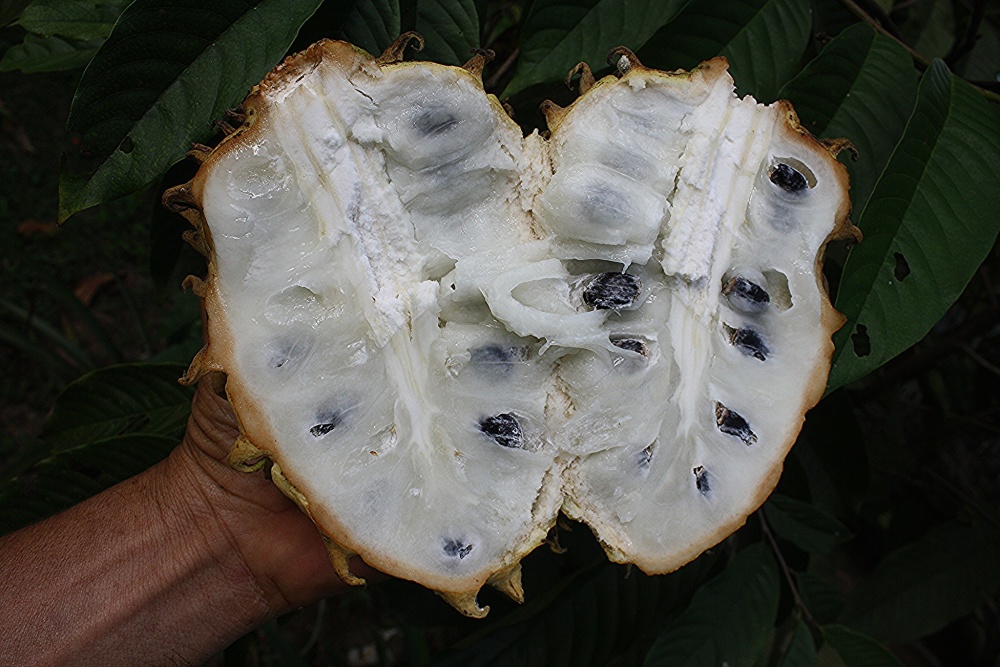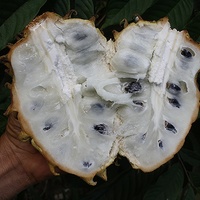Common name: Rollinia
Other common names: Biriba
Description
Rollinia is a custard apple relative originating from the Western Amazon Basin of Brazil. From there, its distribution expanded over many years to neighbouring Peru, Guyana, Suriname, Venezuela and Colombia and in more recent times to the Caribbean, Hawaii, southern Florida and Australia, where it has become a popular fruit tree.
It is a fast-growing shrub or small tree up to 15 m (50 ft) tall, though is more typically from 4 to 9 m (13 to 30 ft) and develops a densely leafy, initially pyramidal-shaped crown, becoming rounded with age. The bark smooth and grey-brown.
The leaves are elongated-oval, 15 to 25 cm (6 to 10 in) long, light to dark glossy green and prominently ribbed on top, finely hairy underneath and leathery in texture. They are alternately arranged along the stems and are briefly deciduous, detaching and falling to the ground in the dry season.
The flowers are 2 to 3.5 cm (0.8 to 1.4 in) wide and made up of two sets of three petals, one set within the other and with the fleshy green outer set the most conspicuous. They are perfect, with both female and male parts and are borne singly or in two's or three's along the stems, mostly in spring, coinciding with the transition from the dry to the rainy season. High humidity conditions are needed for successful pollination, which is carried out by beetles and other insects.
Fertilised flowers develop into heart-shaped fruit ranging from 10 to 20 cm (4 to 8 in) in length and width, and 1 to 2 kg (2 to 4 lbs) in weight, though fruit weighing up to 5 kgs (11 lbs) have been reported. The rind is leathery and rough with teat-like spikes, when young green, becoming lemon-yellow and soft when ripe. It protects a creamy-white, custardy or translucent pulp embedded with glossy dark brown seed.

Photo by Ahmad Fuad Bin Morad
Use
The ripe fruit is eaten fresh out-of-hand by slicing it through and scooping out pulp, which is aromatic, soft and juicy with a smooth, custard-like texture and a pleasing subacid to sweet flavour. It is arguably the most delicious of the custard apples, with descriptions of its flavour likened to lemon meringue pie and apple custard.
Aside from being eaten fresh out-of-hand, the de-seeded pulp is used for flavouring drinks and desserts, including dairy desserts such as yoghurt and ice-cream. The fruit is at its best flavour just before it is fully ripe, when the rind is mostly but not completely yellow, with small areas of green still visible. Fully ripe or overripe fruit tend to be less flavoursome and the pulp may even be insipid.
Climate
Grows naturally in humid subtropical and tropical climates, generally frost-free areas with annual lows of 13 to 25°C, annual highs of 24 to 35°C, annual rainfall of 1000 to 4500 mm and a dry season of 4 months or less.
Growing
New plants are usually raised from seed, though vegetative propagation also gives good results. The seed remain viable only for a short time and should be planted soon after removal from the fruit. They are best sown in containers with a free-draining potting mix and translated when the seedlings are 40 cm (1.3 ft) or more in height.
Performs best on deep, fertile, free-draining loam and sand soils of a moderately acid to slightly alkaline nature, generally with a pH of 5.0 to 7.5 and on sites with full to partial sun exposure.
It has good tolerance to seasonal flooding, but poor tolerance to slow-draining soils and drought, with trees suffering water stress during dry periods lasting longer than three to four months. Because of its drought intolerance, the tree benefits from a thick layer of mulch over the roots to conserve water, especially in areas near the lower end of its rainfall range and where the dry season is pronounced.
It is an early bearing tree, which under favourable conditions starts to flower and fruit at two to three years old.
Varieties common in Australia include 'Limberlost' (a heavy bearer of small fruit), 'Picone' (a consistent cropper of large, juicy fruit) and 'Sputnik' (lemon meringue flavoured fruit). Other varieties include ‘Regard’ (from the Philippines), ‘Prolific’ (from Florida) and ‘Liso’ (from Brazil).
Problem features
It produces fruit with viable seed, but there does not appear to be any record of it anywhere as having escaped cultivation, as a weed or as an invasive species. It is assessed as a low weed risk species for Hawaii, by the Hawaii Pacific Weed Risk Assessment project (HPWRA).
Where it grows
References
Books
-
Food and Agriculture Organization of the United Nations (FAO) 1986, Food and Fruit-bearing Forest Species, 3 : Examples from Latin America, FAO Forestry Paper no 44/3, Rome
-
Morton, J. F. & Dowling, C. F. 1987, Fruits of warm climates, Creative Resources Systems, Winterville, North Carolina
-
Page, P. E. 1984, Tropical tree fruits for Australia, Queensland Department of Primary Industries (QLD DPI), Brisbane
-
Queensland Department of Primary Industries and Fisheries (QLD DPI) 2008, Queensland tropical fruit : the healthy flavours of North Queensland, Brisbane
-
Randall, R. P. 2007, The introduced flora of Australia and its weed status, Cooperative Research Centre for Australian Weed Management, Glen Osmond, South Australia
Articles, Journals, Reports and Working Papers
-
Watson, B.J., & Moncur, M. 1985, Guideline criteria for determining survival, commercial and best mean minimum July temperatures for various tropical fruit in Australia (Southern Hemisphere), Department of Primary Industries Queensland (DPI QLD), Wet Tropics Regional Publication, Queensland


